Genre: Maze Chase Developer: NCS Publisher: Dreamworks Players: 1 Released: 1990
It only takes one good look at its box art for Trampoline Terror! to turn somebody off. But what’s also true of the 1990 DreamWorks puzzle/platform release is that just as cursory a taste of the game in action results in an equally sour response. With a concept as laughable as Trampoline Terror!‘s, one that involves steering a brave gymnast hero across trampoline-littered floating platforms to save both the queen and the entirety of the planet from a destructive empire, there had better be some kind of earth-shattering redefinition of gameplay mechanics contained within. There isn’t!
Big surprise, but I don’t think there were any Sonic-like aspirations for Trampoline Terror!, as its entertainment value doesn’t run throughout the course of the game, let alone leave room for any potential sequels. It loses steam at about the midway mark, and that’s never really a good sign for a game. But that’s also half a compliment, as it implies that for at least some of the game an enjoyable experience can be achieved.
TT! starts off simply enough, with easy puzzles that set up the basic course of action you’re to go about in every level: maneuver your way across the platforms in such a way that you end up walking over every switch, and in doing so destruct the platform altogether (also, you can somehow fly away just before their destruction. Wouldn’t that ability kind of eclipse the whole gravity-based gymnastic talent thing? Call me crazy).
The surfaces you jump around on are set in 16×16 grids, and they consist of four types of platforms: trampolines, tiles, switches, and warps. Trampolines allow you to jump at greater distances than tiles, but they wear down and change color with each jump until eventually disappearing altogether. Tiles are most common, and they’re stronger than the trampolines (they never break), but they also don’t provide for as distanced a jump as the trampolines do. Warps, predictably, transport you from one spot to another. And switches are what you’re after in each level. They come in four different colors: red, blue, green, and yellow, just like every other non-warp platform in the game. But if you hit switches of the same color consecutively, you’re awarded more points. If you hit enough of the same color in a row (up to four), you’re given extra lives, invincibility, or even a free ride to the next level, all depending on which color the switches are.
You can also pick up “P-Balls” that you can throw at the enemies of Ahas, the planet Terror! takes place on. It only takes on hit with a P-Ball to kill each bad guy. If thrown on a trampoline platform however, the ball will bounce until it hits a tile, switch, or open air, with the last option resulting in a permanent loss of the P-Ball. The enemies are a pretty standard and boring fare, mostly consisting of sprites that just walk around on the surfaces hoping to run into you. Some of them are very annoying though, as they’ll hunt you down and make you want to cry out of frustration at their relentless desire to kill you.
So, Between the pretty childish story, simple game play, and that brutal box art, you’d expect this game to be suited more for children than adults. And on the surface, yeah, it’s a kids’ game that doesn’t really catch the eye of the more mature crowd, but Trampoline Terror! is just too hard for kids. The first few levels are deceptively simple, but then you’re blindsided by a bunch of nonsensically hard levels about halfway through. I’ve never considered myself very good at video games, but I know when it’s an overwhelming challenge at play and not just an immense lack of talent weighing me down.
I also know that difficulty alone isn’t reason enough to fault a game – and there have definitely been harder games than Trampoline Terror! – but when that challenge lacks any cleverness, it’s kind of hard to appreciate. As you go along, things start getting carried away: you’re often tossed into messes of random-action enemies and excruciatingly danger-laden switches in levels that don’t seem very thought-out, as if they were hurriedly designed just to tack on another level without any regard to the concept of enjoyment. You spend enough of your time and lives trying to figure out how to approach the level that you’re completely stripped of every ounce of patience you’d previously had, resulting in an accidentally rushed jump into the unforgiving skies of the terrible, terrible planet of Ahas. It gets old fast. And if you do end up making it to the end of the game, you get to fight a boss that is, consistent with absolutely nothing, very easy.
After you stab yourself in the eyes because of the paralyzing difficulty of some of the levels, the graphics won’t mean much, but they’re nevertheless half-decent. The backgrounds start to get a little samey as you get further along, but never to a distracting extent. The colors can be a bit hard to swallow sometimes, I guess, if you find parades of cheery brightness a little cloying.
One of the lone enjoyable qualities of the game is the music. Some of it at least. About half the songs benefit the experience by housing simple and catchy little melodies. Nothing too crazy, just repetitive little tunes that serve this kind of rapid-fire level-changing type of game well. The earlier levels’ music stands out in particular.
Still, maybe it’s just me that finds the game so senselessly hard in certain spots. But hard or not, it’s really not a strong enough mechanic to design a 33-level game behind, and it never really hits a good balance between enjoyment and challenge, except for a handful of levels (about the 8-12 run, pretty much). It stands as a pretty forgotten title in the Genesis catalog, and a good sit-down with Trampoline Terror! will point toward the reasons for that better than any review can. But take my word for it; you’d only be wasting your time.
SCORE: 3 out of 10

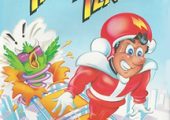
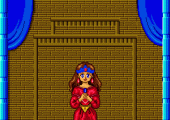
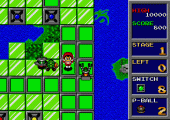
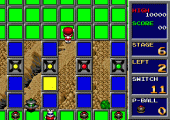
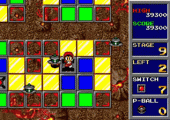
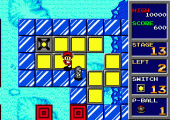
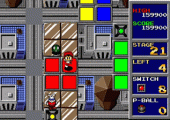
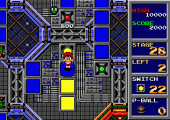
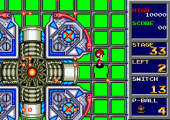
I have no idea what the reviewer’s complaining about — this game is not an “overwhelming challenge” at all. The difficulty does jump abruptly around the halfway point, but other than that it’s a fairly steady climb. Only a few levels are really tricky, most are well-designed, and none of them are anything like as hard as a typical NES action-puzzler, especially since the nastiest levels often include an extra life bonus that you can loop.
I’d give this a solid 7/10. Good production values (except for the manual which has some errors and omissions), attractive graphics, solid controls, nice arcade-style aesthetic. Sure, it’s frustrating when you don’t center a jump, and the Bender heads are annoying on Normal. But the game is never cheap. The worst I can say about it is that it could use a little more variety of enemies, might benefit from a boss every four rounds, and the final boss is too easy.